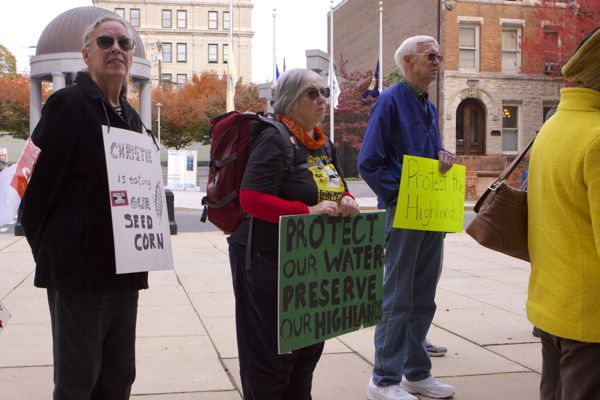USGS Study Shows Continuing Decline In Groundwater Quality, Contrary to Highlands Act
[IMPORTANT Technical Update below]
About 35 citizens and members and staff of the Highlands Coalition, Sierra Club, Environment NJ, ANJEC, Clean Water Action, NJCF, and *Raritan Headwaters Assc. held a rally on the State House steps in Trenton yesterday to oppose the Christie DEP’s recent overhaul of the Water Quality Management Planning rules (WQMP).
I am writing a series on this rule, but have not finished my review of the proposal with respect to the Highlands, so will hold off for now and just post photos and links to the news coverage:
I was troubled by the below DEP press Office statement in the Record story, because it completely misunderstands the policy established by the Highlands Act.
The Act is based on science but is not limited to science. Science can not make normative recommendations about how much we should allow our water quality to decline. So, DEP appears to misunderstand the relationship between science and the policy set by the legislature. The Legislature is not limited to science and can make policy.
The Act seeks to prevent declines of “existing water quality”. It directs DEP to base the groundwater anti-degredation policy on background levels, considering “deep aquifer recharge”.
The Act was written and set that policy with full awareness of the existing DEP science and data, the DEP nitrate dilution models, and DEP regulations on nitrate dilution and anti-degradation regulations (I WAS AT DEP AT THE TIME AND WROTE THE LANGUAGE IN THE ACT).
Based on full awareness of the objectives, limitations and flaws in existing protections, the Act intended to STRENGTHEN then existing requirements to be MORE STRINGENT than the then existing DEP groundwater nitrate dilution model and groundwater quality standards anti-degradation policy.
Fully aware of this legislative mandate and legislative intent, the DEP developed a nitrate dilution model based on this legislative anti-degradation policy (I led the negotiations with DEP on the model as a consultant to the Highlands Coalition).
So, now it appears that DEP is trying to rely on an August 2015 USGS study as a cover for rolling back protections set by the Legislature:
But Larry Hajna, a DEP spokesman, said Tuesday that agency officials are still analyzing the results of a study published over the summer by the U.S. Geological Survey that estimated levels of nitrate in the Preservation Area, one of the key pollutants generated by septic systems.
“We are currently analyzing the results of that study to determine if we need to consider any regulatory changes that reflect this new scientific data,” he said “Until we complete this review, it would not be possible to say if this will result in an increase in septic density in the Highlands.”
Technical Update:
I just scanned the USGS Highlands Nitrate study – the Abstract concludes: (emphasis mine)
… the estimated median nitrate concentration for the entire Highlands Region is about 1.25 mg/L as N, and estimated median concentrations range from about 1.05 to 1.78 mg/L as N among 11 smaller administratively defined areas within the Highlands Region that vary in percentages of urban land use, agricultural land use, and septic-system density.
The current DEP Highlands nitrate model is based on far lower nitrate background levels, which were derived back in 2004-05, based on then existing data:
To apply the model, values for the following model inputs were selected: an annual recharge rate representative of the Highlands region (9.8 inches per year); a number of persons per household unit representative of the region’s population (4 persons per unit); the load of nitrate contributed per system (10 pounds per person per year); and target concentrations of nitrate. Two ambient nitrate concentration standards were selected, 0.21 mg/L for forest land use and 0.76 mg/L for mixed land use.
So, if 10 years later, USGS is now finding HIGHER median background nitrate levels, that shows that existing water quality has continued to decline, contrary to the policy objective set in the Highlands Act to protect existing water quality.
That USGS finding would NOT support a revision of DEP’s nitrate dilution model or any relaxation in the septic density standard – exactly the opposite is the case: even tighter regulations are required to prevent the further degradation of existing water quality.
*corrected eror



